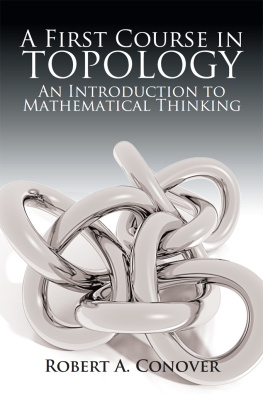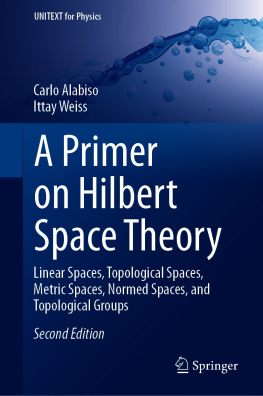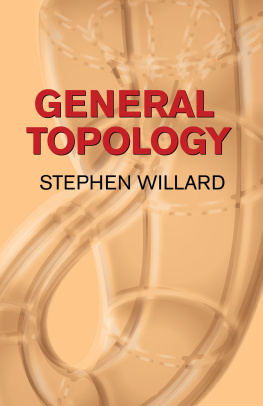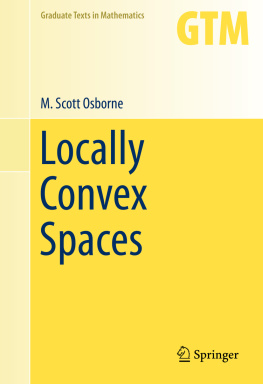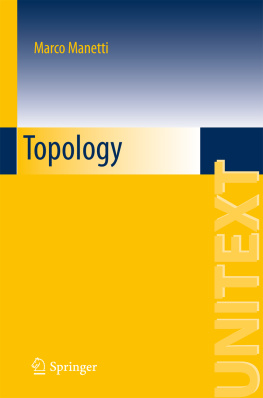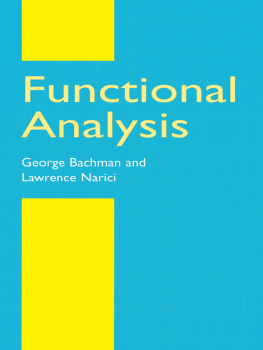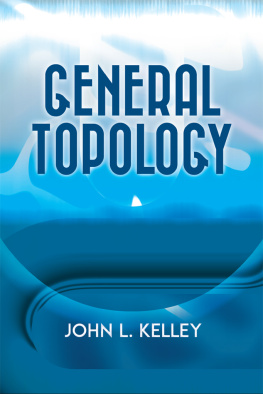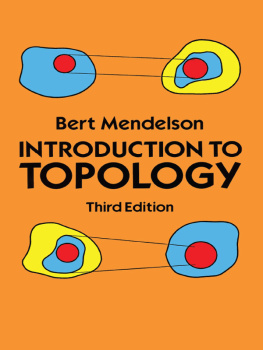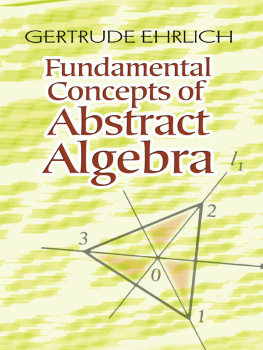A FIRST COURSE IN
TOPOLOGY
AN INTRODUCTION TO
MATHEMATICAL THINKING
ROBERT A. CONOVER
DOVER PUBLICATIONS, INC.
MINEOLA, NEW YORK
Copyright
Copyright 1975, 2003 by Robert A. Conover
All rights reserved.
Bibliographical Note
This Dover edition, first published in 2014, is an unabridged republication of the work originally published by The Williams & Wilkins Company, Baltimore, Maryland, in 1975.
Library of Congress Cataloging-in-Publication Data
Conover, Robert A. (Robert Allyn), 1942
A first course in topology : an introduction to mathematical thinking / Robert A. Conover.Dover edition.
p. cm.
Originally published: Baltimore, Maryland : Williams & Wilkins Company, 1975.
Includes bibliographical references and index.
eISBN-13: 978-0-486-79172-2
1. Topology. I. Title.
QA611.C683 2014
514dc23
2013044347
Manufactured in the United States by Courier Corporation
78001501 2014
www.doverpublications.com
DEDICATION
To A. H. S. and L. D. E. S., without whom this book would not have been possible.
Preface
This book is designed primarily to serve as a basis for a course in topology in which the students prove all or most of the theorems. As such, it can also serve as the basis for a lecture course in which the instructor presents most of the results himself. Probably the best way to use it is for a course conducted somewhere between these two extremes.
It is not just an outline. There is much discussion, as in a regular textbook, and a good deal of this discussion is about how to prove the theorems and why they are important. In addition, some of the harder theorems and examples are given rather complete outlines. For example, I do not think that it is reasonable to expect an undergraduate student to come up with a proof of Urysohn's lemma or the Tychonoff product theorem, nor do I expect that he would discover a (Hausdoff) completely regular space that is not normaland justify itwithout some help. I have found when teaching topology that a very effective method of getting students to understand difficult proofs (and, incidentally, to see that not every proof can be dashed off in a few lines once the method is discovered) is to give them the proof outright from a standard text, and to have them present it completely and in detail in class. The outlines given here are an attempt to improve upon this method.
It is my hope that when this book is used as a basis for a course in which the students present most of the proofs, it will alleviate some of the problems that beginning students have with this way of teaching. For one thing, reading can be assigned and discussed. The student is used to having something to read, and suddenly having nothing at all can be quite a blow. Besides, it is unrealistic to force him to work in a vacuum. Professional mathematicians don't; neither should the student. The problem up to now has been that anything that the student might read at the beginning level contained too muchany supplementary text turned out to be an answer book. This book solves that problem.
Probably the biggest complaint about teaching from an outline concerns content: it is said that the better students learn something about how to do mathematics, but they do not learn much topology, and the average student learns just about nothing. I do not agree with this complaintnot if the course is handled properlyand this book is an attempt to give the beginning student (who, after all, has not had much experience in doing mathematics on his own), something to hang onto until he develops some confidence. Additionally, by relating new concepts to old ones and by spiraling back to topics already covered, this book should help everyone come out of the course with a pretty good foundation in topology, as well as with some experience in doing mathematics.
The question of exactly what a good foundation in topology is seems to be an open one. It is my impression that many students come out of their first course in topology totally missing the point, probably because most books try to be totally rigorous at all times, and will not allow any hand-waving, even at the beginning, thus rendering themselves pretty trivial and pretty static. Topology is anything but static, and most students have some idea of rubber sheet geometry, but they usually do not see any in most first-year courses. Part of is an attempt to get the student to think topologically in terms of pictures, as most mathematicians do when they do topology. Students should have a lot of fun with it, and hopefully, they will become excited and curious enough to want to see more. In order to be able to present this advanced material so early in the course, we are sometimes forced to resort to descriptions instead of definitions, and some exercises begin with convince yourself instead of prove. The difference is clearly pointed out, and the student is never asked to prove anything until a proof is possible. (There is a recent calculus book which asks the reader to prove that a certain function is continuous, without ever giving a definition of continuity.) Every theorem in this book is indeed a theorem which can be proved.
About content. Most of the material is standard point-set topology (except, of course, for the last chapter) which, as Kelley says, is what every young analyst should know. Continuity is emphasized throughout. The space of countable ordinals is an important example in many cases, an example which is realistic and not made up just to illustrate a particular point. However, not everyone will agree that undergraduate students can understand this space at least as well as they understand the space of real numbers, and those who do not can eliminate any discussion of ordinal numbers and still use this book. Examples other than ordinal spaces are presented when it seems feasible, and it is always clearly stated when a particular section, theorem, or example requires using the space of countable ordinals. (Larger ordinals are not used at all.) Similarly, any discussion of product spaces with infinitely many factors can be omitted (with the resulting loss of content, of course); as with ordinals, places where infinite products are used or needed are clearly pointed out. The student is constantly asked to establish examples of spaces that have the various properties discussed, as well as examples of spaces that do not have the property. Before doing so, he is always asked to state precisely what it means when a space does not have the property under discussion, or when the particular property at hand does not hold. This serves two purposes: first, he knows precisely what to look for in a counterexample, and, second, he learns to work with mathematical phraseology and to appreciate the precision of a mathematical statement.
There is enough material here for a full year course. However, by picking topics, one can construct a one-semester course as well. With the thought of eliminating certain sections in mind, no topic is introduced solely in the exercises if it is to be used later. Rather, if a topic is needed that was previously discussed in an exercise, it is defined again, the relevant properties are pointed out again, and a reference to its initial discussion is given so that the student can see how it arises naturally.
A student who has had, or is taking, a course in advanced calculus and who is willing to work should be able to handle the material presented here, except for the last chapter, where a knowledge of elementary group theory is required. It has been my experience that most students who take a course like this one become very interested and are willing to work very hard indeed. As a result, they learn a great deal about mathematics, and quite a bit of basic topology as well.
Next page
